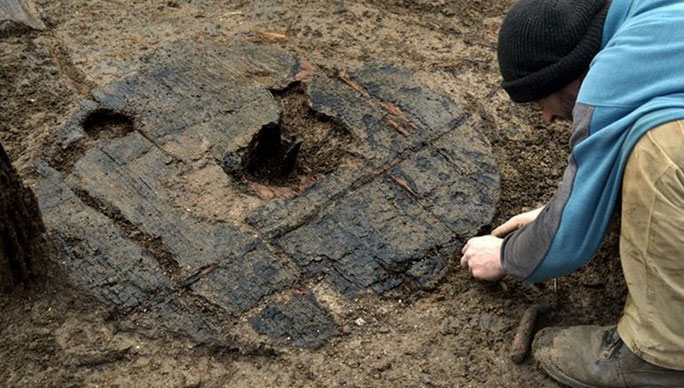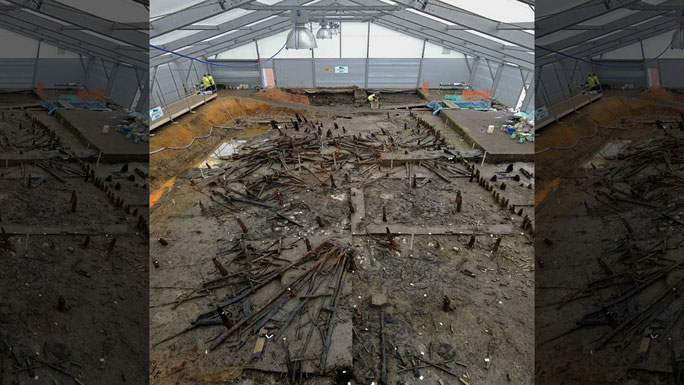The 3,000 year old swamp carries a 'monster' in his body
The remains of a swamp village were miraculously preserved after a fire 3,000 years ago, helping archaeologists from Cambridge University recreate the surprising picture of an "Pompeii of England". in a recent article published in the journal Parasitology.
Excavation shows that the area named Must Farm in East England was once a vast bronze settlement that dominated the swamp, with stilt houses built on water and the main means of transport. are wooden boats. 3,000 years ago, a fire completely burned down the old village, and also accidentally caused many antiques and human traces to fall into the deep mud. Because mud is one of the most effective natural preservation environments, today, many artifacts are nearly intact when excavated.

An archaeologist is working on the excavation area to get out of the mud a giant wooden wheel - (photo courtesy of the team).
The most surprising are the traces of people here: most of them carry in their kidneys a parasitic worm with a length of over 3 feet (about 1m) . These small "monsters" may come from their daily menu: live fish, frogs and shellfish living in the swamp.

The excavation area still has traces of wooden stakes and wooden floors, traces of a village built right on the swamp - (photo courtesy of the research team)
According to Professor Piers Mitchel, from the University of Cambridge's Department of Archeology, the lead author of the study, they have found many extremely well-preserved deadly parasites. These include fish tapeworm and Echinostoma worms that cause anemia; Giant kidney worms - the "monsters" that are 1m long - quickly kill their hosts. The dogs raised in the village were also victims of the parasite, showing that the owner and the pet shared the same menu.
The cause of the swamp village was dubbed the "Pompeii of England" because such construction and organizing techniques were surprising 3,000 years ago. At the same time, the village was wiped out by fire like Pompeii - the famous Roman city was wiped out in a volcanic eruption 2,000 years ago.
In the previous preliminary survey, archaeologists also found many types of jewelry and fine craftsmanship, showing that the people here developed very early in handicrafts.
- 2,000 year old village in Jerusalem
- Mysterious and strange village people don't dare to wear shoes
- The 600-year-old sword of a knight died in the swamp
- Terrible facts about life in the swamp
- The butter is still eaten after 2000 years buried in the Irish swamp
- Loch Ness monster monster objects head up on the lake
- Secrets at the 'swallowing swamp' led to a headache from the US Geological Survey
- The constant debate about the 300 million-year-old Tully monster
- Great recipes to help you get out of the marshes
- 10 most famous aquatic monsters of all time
- Mysterious skinhead monster in Japanese legend
- The most convincing picture of the Loch Ness monster
- Finding dinosaurs like the Loch Ness monster
- Congo: discovered large swamp containing billions of tons of peat
 Discovered an ancient centipede fossil 99 million years old
Discovered an ancient centipede fossil 99 million years old Discovered bat-like dinosaurs in China
Discovered bat-like dinosaurs in China Discovered a 200-year-old bronze cannon of the coast
Discovered a 200-year-old bronze cannon of the coast Discover 305 million-year-old spider fossils
Discover 305 million-year-old spider fossils